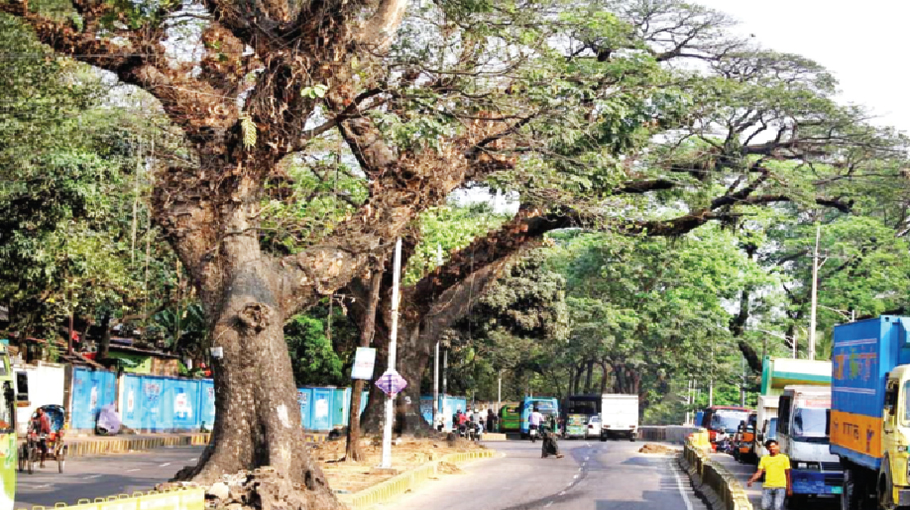Ctg Elevated Expressway
CDA to cut down century-old trees to build ramps, citizens protest


The Chattogram Development Authority (CDA) has taken decision to cut down hundred-year-old trees in the CRB area for the construction of ramps to facilitate traffic on the Chattogram Elevated Expressway.
According to sources, the Elevated Expressway will have 15 ramps, which will be constructed through the CRB area of Chattogram city up to Tigerpass junction. CDA got permission from Forest Division (North) to cut down these trees.
The implementing agency, CDA, has decided to cut down 46 more trees. On March 19, Chattogram Forest Division (North) completed the marking of these trees and gave CDA a licence to extract forest products.
According to the licence, 11 cardamom trees, four DC trees, 2I pil, one black cherry tree, three mahogany trees, and one guava tree will be felled. Apart from this, 24 other fuel trees have to be cut down. Pinky Kumar Dhar, forester of forest department, marked these trees.
However, some environmental organisations have announced their plans to prevent the move for cutting down these trees.
Regarding the construction of the ramps by cutting down trees, Mayor Mohiuddin Chowdhury-CDA Expressway Construction Project Director and CDA Executive Engineer Mahfuzur Rahman said that these trees have to be cut down for implementing the project.
“But we are trying to cut down less trees. CDA will cut down some big trees. However, 45 trees have been identified. We got permission from forest department to cut down the trees between the two roads. The construction of the ramps will start after cutting down the trees and getting permission from the ministries concerned,” he added.
SM Kaiser, Divisional Forest Officer at Chattogram North Forest Division said, “We are cooperating with the government project as per rules. But the place is owned by the railway ministry and CDA. We cannot do anything violating rules. Approval has been given for cutting down of 46 trees.”
On Monday morning, more than 100 different species of trees, small and large, were visible on the ground from Pologround to Tigerpass Junction. Among them, there are about 50 big trees. Besides, there are 75 more trees in small and medium size.
CDA Chief Engineer Hasan Bin Shams said, “We have sought permission from the Environment and Forest Department to cut down about 45 trees. The trees will be felled as much as needed in the project. We have taken initiative to cut down trees and build ramps in the public interest. There is no chance to build these ramps anywhere else. These trees will be cut down and more trees will be planted, if necessary.”
It is learnt that Prime Minister Sheikh Hasina inaugurated the 16-km long expressway from Lalkhan Bazar to Patenga in Chattogram city on November 14 last year by unveiling a plaque from Ganobhaban. But the CDA could not open the expressway as the construction work has not been completed yet. The Executive Committee of National Economic Council (ECNEC) approved the project at a meeting on July 11 in 2017. The project cost was estimated at Tk 3,250 crore. Later, the cost for design change was increased to about Tk 4,299 crore. The project is scheduled to be implemented by June 2024.
Chattogram's first elevated expressway has been named after late city mayor and freedom fighter ABM Mohiuddin Chowdhury. However, toll from a minimum of Tk 10 to a maximum of Tk 450 have to be paid for using the expressway.
Citizens protest cutting of century-old trees
Meanwhile civil society members in Chattogram protested the planned cutting of 46 century-old trees from Tigerpass to Pologround for the construction of a ramp for the Chattogram elevated expressway.
The trees stand along Mohammad Yusuf Chowdhury Road, a historic road built during the British era. The Chattogram Development Authority (CDA), the project's implementing agency, included cutting these trees and altering nearby hillslopes in their design.
The century-old trees on the road are a part of Chattogram's heritage and crucial for the city's well-being.
To save the trees, environmentalists under the banner of the Samilito Paribeshh Raksha Andolan gathered at the spot on Monday. They held signs demanding the protection of the trees and chanted slogans like "Free the trees from the saw of development!" and "What harm does a living tree do to you?"
Professor Muhammad Sikandar Khan, president of the Planned Chattogram Forum, expressed outrage. He criticised decision-makers for lacking awareness of the environmental benefits these trees provide. "They do not know the benefits we get from nature. Those who make these decisions should be trained," he said.
Later that day, a group of social activists, environmentalists, and journalists formed another human chain and held a protest rally under the banner of civil society. Environment activists condemned the CDA's past actions like cutting hills on Bayezid Link Road.
The protest follows a previous successful movement that stopped the construction of a hospital on land in the CRB, known as the city's "lung".
The CDA is constructing a 16 km elevated expressway from Lalkhan Bazar to Patenga, which is nearing completion. The project includes 15 ramps. The CDA is seeking permission from Bangladesh Railway to use the land for two ramps in Tigerpass and Agrabad areas.
While the CDA claims only small trees will be cut, environment activists are concerned about the potential loss of century-old trees and the overall environmental impact. The contractor has already marked 46 trees for cutting from the ramp construction.
CDA Chief Engineer Kazi Hasan Bin Shams downplayed the controversy. He said no century-old trees would be cut and only minor modifications would be made to larger trees. However, environmentalists remain skeptical and are urging the involvement of the Department of Environment and the Forest Department before any trees are cut.
However, the approval process for the construction of the expressway ramp is ongoing,
The fight to save the trees highlights the importance of balancing development needs with environmental protection.



